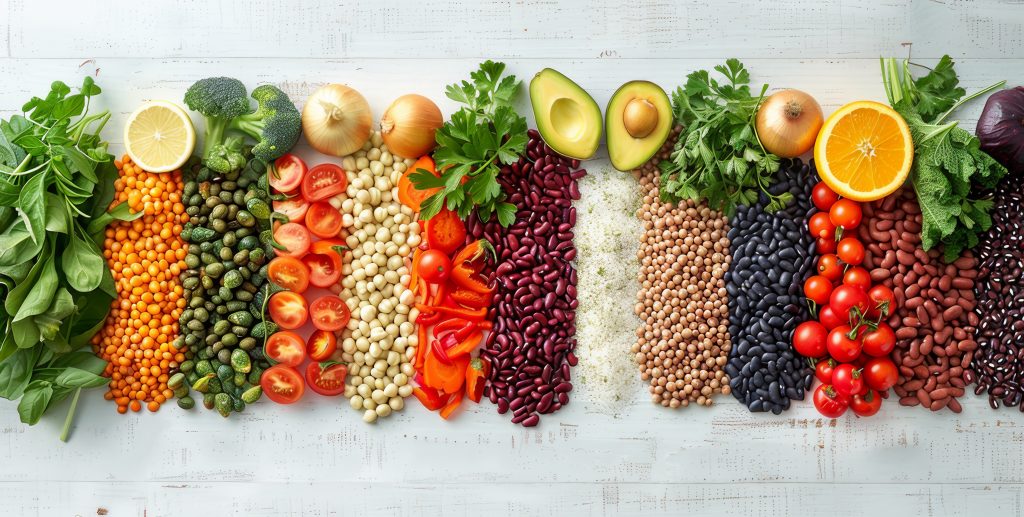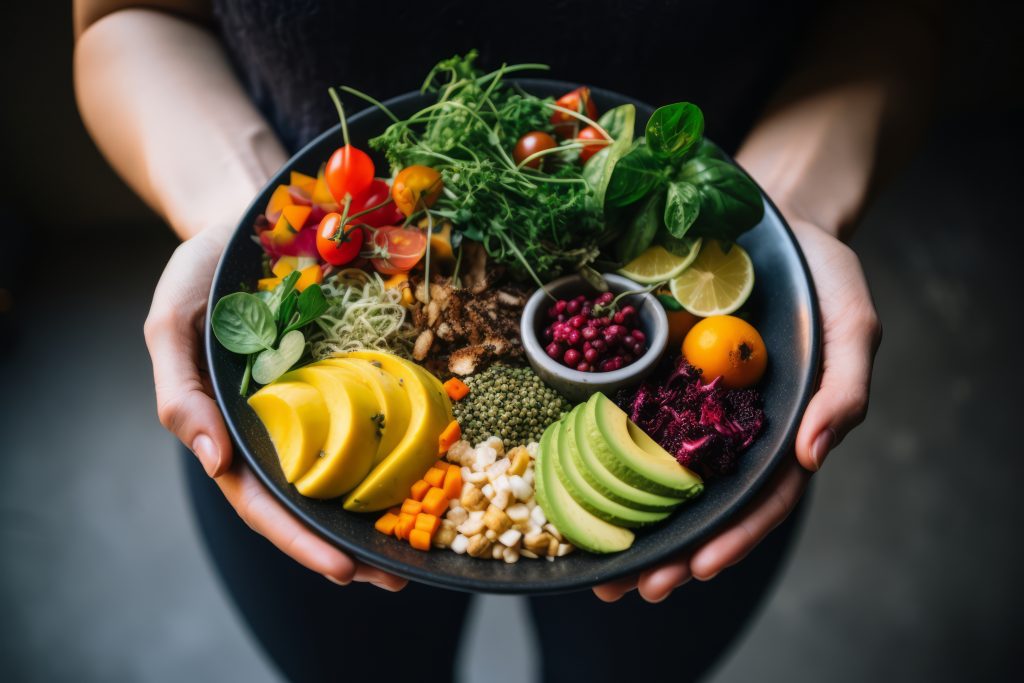
Thinking about adding more plants to your plate? You’re not alone! Plant-based eating has been gaining popularity for good reason—it’s tasty, versatile, and a great way to nourish your body and the planet. Let’s break it down together, nice and simple.
What Is Plant-Based Nutrition?
Eating plant-based might sound fancy, but it’s really simple—it’s about putting plants at the heart of your meals. Think of your plate filled with colourful fruits and veggies, hearty whole grains, creamy nuts and seeds, and protein-packed legumes like lentils and chickpeas.
The great thing is, plant-based eating doesn’t have to be all-or-nothing. You don’t have to give up your favourite foods overnight or ever, if you don’t want to. It’s more about adding, not restricting—more plants, more variety, and more flavour. Plant-based foods are naturally rich in fibre, which is essential for healthy digestion and keeping you feeling full and satisfied.
There’s also no one-size-fits-all. Some people go fully plant-based (like vegans who skip all animal products), while others choose to eat mostly plants but still enjoy a little meat, cheese, or fish now and then (i.e. flexitarian). The best part? You get to decide what works for you.
Why Choose a Plant-Based Diet?
If you’re wondering why plant-based eating is worth a try, let me share a few reasons with you! From improving your health to helping the planet, there’s a lot to love about this way of eating.

Health Benefits
Eating more plants can do wonders for your body. Research shows it can lower your risk of chronic conditions like heart disease, diabetes, and even certain cancers. Plus, it’s great for digestion—thanks to all the fibre in fruits, veggies, and whole grains—and many people say they feel lighter and more energized after switching to a plant-focused diet. Who doesn’t want that?
One big perk of eating more plants is the fibre boost. Fibre supports digestion, keeps your blood sugar steady, and can even help lower cholesterol levels. Most of us don’t get enough of it, and plant-based eating is a simple way to change that.
Environmental Impact
Plant-based eating isn’t just good for you; it’s good for the Earth, too. Producing plant foods generally uses less water and land and creates fewer greenhouse gases compared to animal-based foods. So every time you enjoy a veggie-packed meal, you’re also doing your bit to protect the planet.

Budget-Friendly
And let’s not forget your wallet! Beans, lentils, rice, and seasonal veggies are some of the most affordable and filling foods out there. Going plant-based doesn’t mean buying fancy substitutes or trendy ingredients—simple staples can go a long way.
Eating plant-based doesn’t have to cost a fortune—in fact, it can save you money. Staples like lentils, beans, rice, and chickpeas are affordable and can stretch into multiple meals. Shopping for fresh, seasonal produce not only lowers costs but also gives you the best-tasting fruits and veggies. Buying dry goods like grains and legumes in bulk can help you save even more, while frozen fruits and vegetables are a budget-friendly option that lasts longer and reduces waste. By planning meals around what’s already in your pantry and getting creative with leftovers, plant-based eating becomes both economical and practical.
You don’t need to buy specialty items like vegan cheeses or mock meats to eat plant-based. The beauty of this lifestyle is that it thrives on simplicity—real, whole foods that nourish you without emptying your bank account.
Simple Tips to Get Started
Starting a plant-based diet might sound like a big change, but it doesn’t have to be! When I first started exploring plant-based eating, I kept it simple and took things one step at a time. Here are a few tips that worked for me (and might work for you too):
1. Start Small
When I first tried a plant-based meal with the family, it was a veggie stir-fry with tofu (for my kids) and they loved it. Pick one meal a week, like Meatless Monday, and have fun with it. It’s amazing how small changes can add up.
2. Make Swaps
I started by swapping cow’s milk for almond milk in my drinks—it was such an easy switch! Then I moved on to things like using mashed avocado instead of butter on toast or lentils in my tacos instead of ground beef. You’ll be surprised how little changes can become second nature.
3. Focus on Variety
One of my favourite parts of eating more plants is discovering foods I’d never tried before. Ever roasted chickpeas for a crunchy snack or cooked quinoa and topped it with roasted veggies? Trying something new keeps meals exciting and delicious.

4. Keep It Balanced
I’ll be honest, at first, I wasn’t sure how to build a balanced plant-based meal. But then I started thinking about it in simple terms: a grain, a protein, some veggies, and a healthy fat. A bowl of brown rice, sautéed greens, chickpeas, and tahini drizzle? Perfection.
5. Plan Ahead
Meal prep saved me so much time (and stress). I like to roast a big tray of veggies, cook some quinoa, and keep a jar of homemade vinaigrette in the fridge. That way, I’ve got plenty of mix-and-match options for quick, easy meals during the week.
Common Concerns and How to Address Them
Starting something new often comes with a few questions or concerns. But don’t worry, you’re not alone—let’s tackle some of the most common ones:
“Where Do I Get My Protein?”
When I first thought about plant-based eating, I wondered about protein too. The good news is that plants are packed with protein! Foods like beans, lentils, tofu, quinoa, and nuts are all great sources. But if you have allergies or sensitivities—like to soy, legumes, or nuts—there are plenty of other plant-based options to explore.
For example, you can replace lentils or beans with quinoa or edamame (if you’re not sensitive to soy) for that protein punch. You can also try pumpkin seeds, sunflower seeds, or chia seeds as protein-rich alternatives to nuts. If tofu isn’t an option, tempeh (fermented soy) could work for some people, or you can go for seitan (wheat gluten) if you’re not gluten-sensitive.
And don’t forget, many veggies like spinach, broccoli, and peas have protein, too. Once I started getting creative with my meals, I realized how easy it was to hit my protein goals, even without my usual favourites.
“What About Iron and B12?”
Iron is found in plenty of plant foods like leafy greens, lentils, and fortified cereals, but it’s important to pair them with vitamin C-rich foods (like peppers, citrus, or tomatoes) to help your body absorb it better. As for B12, it’s trickier—it’s mostly found in animal products. If you’re planning to go vegan, be sure to look for fortified plant-based options like plant milks, nutritional yeast, and other vegan products that contain added vitamin B12 (look for cyanocobalamin on the label). Checking food labels is important to ensure you’re getting enough of this essential nutrient, as it’s not naturally found in plant foods. A quick B12 supplement never hurts either, just to be sure!
“It’s Too Hard to Be Perfect.”
I’ll be the first to say it: don’t stress about being perfect. If you have a burger or some cheese every once in a while, no worries! This journey is about progress, not perfection. Every plant-based meal you try is a win.
Easy Plant-Based Recipes to Try
Once you’ve got the hang of plant-based eating, you’ll be craving simple, flavour-packed meals. Here are a few easy recipes to get you started:
1. Chickpea and Veggie Stir-Fry
A one-pan wonder. Sauté chickpeas with your favourite veggies (broccoli, bell peppers, and onions work great), add a splash of soy sauce, and serve over rice or quinoa. This is a meal you’ll come back to again and again!
If you are allergic to chickpeas, you can replace with seitan – if gluten is not an issue. It can work as a meat-like protein with a chewy texture. Another is Tempeh (if not allergic to the fermentation process). Although tempeh is made from soy, some people who are allergic to soy can tolerate it due to the fermentation process. If that’s the case, it can work as an alternative.
2. Lentil Soup
A hearty, comforting soup that’s packed with fibre and protein. Throw some lentils, tomatoes, carrots, onions, and spices into a pot, and let it simmer. You’ll have a filling meal ready in no time.
3. Overnight Oats
If you’re looking for a quick breakfast, try overnight oats. Mix rolled oats with almond milk, chia seeds, and a drizzle of maple syrup, and let it sit in the fridge overnight. In the morning, top it with fresh berries and nuts for an energizing start to your day.
Plant-based eating doesn’t have to be intimidating—it’s all about making small, enjoyable changes that work for you. Whether you’re going full plant-based or just want to add more plants to your plate, the benefits are clear: better health, a lighter environmental footprint, and a fun variety of flavours to explore. Take it one meal at a time, get creative with your choices, and most importantly, enjoy the process!
Remember, there’s no perfect way to eat—what matters is finding what makes you feel your best. So why not give it a try and see how you feel? I’m excited for you to explore this journey and see where it takes you. It’s been such a rewarding experience for my family and I, and I hope it brings you as much joy and nourishment as it has me.